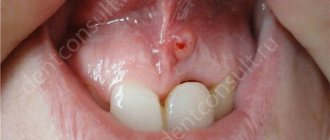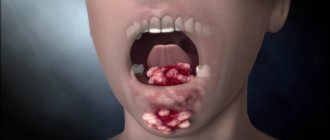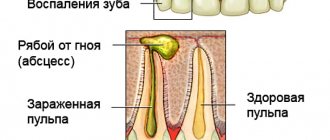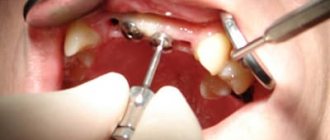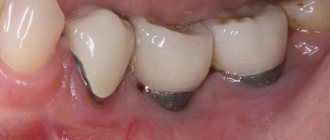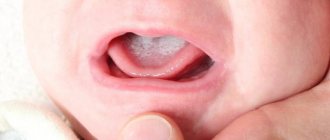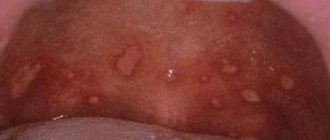Is it possible to trim the frenulum of an adult's tongue?
The frenulum of the tongue is a membrane on the oral mucosa that is located directly under the tongue.
It extends from the middle of the tongue to the gums of the lower front incisors, connecting it with the oral cavity in the lower jaw. This fold serves to hold the tongue when it is pulled to the side, which is why it was named this way. There is an anomaly called ankyloglossia. With it, the frenulum does not come from the middle of the tongue, but from its tip, which limits its mobility. If the operation was not performed in childhood, then the question is likely to arise: is it possible to trim the frenulum of the tongue in an adult?
When should the frenulum be cut?
Frenulotomy is an operation in which the frenulum of the tongue is cut; it is not very complicated and is done under local anesthesia . After this procedure, children recover quickly and can return to their normal lifestyle within a couple of hours.
In infants, this operation is performed when the frenulum prevents him from receiving breast milk; in other cases, it is not necessary. For newborns, the operation is performed without anesthesia; only the sublingual film of connective tissue, which has practically no nerve endings and blood vessels, is dissected.
Functions and signs of ankyloglossia
In the human mouth there are not one, but three frenulums : on the upper lip, on the lower lip and, in fact, on the tongue. All three serve to perform several functions at once, which include:
- formation of correct diction;
- normal functioning of the oral mucosa;
- creating conditions for normal food intake;
- formation of correct bite;
- maintaining the functionality of the facial muscles.
A short frenulum of the tongue is a common phenomenon.
Approximately one in twenty people are born with a short frenulum . Moreover, 75% of them are male. Determining on your own whether the frenulum is short or not is not so easy, since there may be no visible signs.
However, there are a number of indicators from which certain conclusions can be drawn:
- bending of the tongue down when it is pulled forward;
- violation of swallowing and sucking function;
- obstacles to fully extending the tongue;
- problems with bite formation;
- periodontal diseases;
- the formation of a heart-shaped tongue when it is raised;
- violations of diction and correct pronunciation.
What does a shortened frenulum look like?
Violation of the frenulum length can be understood in three ways:
- Firstly , the baby cannot stick its tongue out of its mouth, only slightly raising and lowering its edge. To test this reflex, you can run your finger over your baby's lips. In a normal reaction, the baby sticks his tongue out quite far, moving it around his lips in search of mother's milk.
- Secondly , the surest way to identify a small frenulum is to watch your child cry. When screaming, the tongue should rise strongly, and if there is a disease, only the very tip will lift up.
- Thirdly , a child with a frenulum defect cannot reach the palate with his tongue.
If these signs are not enough for parents to be convinced of the need for treatment, they can contact any pediatrician for a diagnosis.
The photo shows a short frenulum of the tongue
Indications for the use of plastic surgery
- Difficulty with breastfeeding . This problem occurs in a quarter of all babies with a short frenulum. Due to the limited mobility of the tongue, the baby is not able to properly grasp the mother's nipple, which is why, in the future, problems such as malnutrition and slow weight gain appear. As a rule, a short frenulum of the tongue in a newborn can be diagnosed by a pediatric neonatologist in the maternity hospital. Already there, a simple dissection of the sublingual or other frenulum can be performed.
- Difficulties in pronunciation . Typically, such a deviation is detected by a kindergarten speech therapist. This is explained by the fact that the tongue, constrained in its freedom, does not allow all sounds to be pronounced correctly. If left unattended, such a problem may subsequently persist as a speech defect. And then plastic surgery of the frenulum of the tongue in adults will become their opportunity to correct their speech.
- Orthodontic reasons . A short frenulum of the tongue can affect the curvature of the dentition, tilting the incisors inward, and also inhibit the development of the lower jaw. In addition, this pathology greatly complicates orthodontic treatment.
- Periodontal reasons . A shortened frenulum can cause gum recession, which exposes the root of the tooth and makes it more vulnerable to disease and damage, as well as compromising its stability in the gum.
The tongue without a short frenulum is mobile and comfortable
Many positive reviews of cutting the frenulum of the tongue in adults today indicate the popularity of this procedure. Mainly in connection with the development of prosthetics on implants, since ankyloglossia can disrupt the nutrition of the tissues surrounding the implant.
It is worth saying that the frenulum of the tongue, which is trimmed relatively infrequently in adults, takes a little longer to heal than in preschool children. In general, plastic surgery is considered most acceptable from the age of 5-6 , if it was not performed in infancy in order to eliminate breastfeeding problems. During this period, the central incisors have already at least partially erupted, but the lateral incisors have not begun, which simplifies the operation.
One of the surgical options
Signs of pathology
A congenital defect of the frenulum is detected by a number of signs. They are visible to the naked eye and are diagnosed by a doctor during the initial examination of the newborn.
The main one is the unusual shape of the tongue with the tip slightly pulled down. It looks a bit like a small heart.
There are secondary factors that manifest themselves during feeding in the baby and the mother:
- The baby smacks his lips and releases the nipple, which increases the duration of the feeding session and, in general, it becomes quite difficult to feed the baby.
- Without eating, the baby gains weight worse.
- Due to poor nutrition, colic occurs more often in a child. He regurgitates food.
- The pathology does not allow the newborn to hold the mother's breast correctly, which is why cracks and bite marks remain on the nipple, and less milk is produced.
If these symptoms appear, you should take a close look at the child.
Contraindications and practices
Like any other surgical operation, correction of such a defect as a short frenulum of the tongue in an adult has its contraindications . In most cases, these are pathologies and diseases of the body, about which the doctor must be notified before the procedure begins.
These include:
- chronic diseases of the oral cavity during their exacerbation;
- oncological diseases of the jaw tissue;
- infectious diseases of the body as a whole;
- blood clotting disorders;
- mental disorders;
- poor oral hygiene.
Incision of the sublingual skin fold in infants is called a frenectomy or frenulotomy , depending on the type of incision. Since at this stage the frenulum does not contain blood vessels, there is usually no bleeding.
Otherwise, it is stopped through breastfeeding. In older adults, the operation requires local anesthesia and is called frenuloplasty .
This is done in several ways:
- Cutting . After cutting the sublingual frenulum, retaining transverse sutures are placed on its edges.
- Removal . After two triangular incisions, the frenulum disappears and the remaining wound is closed with stitches.
- Moving . Two incisions separate part of the frenulum, after which it is attached to the site of an artificially tapered wound.
Correcting a short frenulum of the tongue is an important procedure and is worth deciding on.
Trimming a bridle for an adult is still quite simple. The operation lasts no more than 20 minutes, and the sutures are made of biodegradable material and disappear on their own after a few days. In addition, modern technologies make it possible to use laser correction . When using a laser, there is no bleeding or need for stitches.
As a rule, there are no complications after surgery. The rehabilitation period lasts no more than a week. However, for successful wound healing, several conditions must be met. In particular, it is necessary to maintain daily oral hygiene, avoid hot and hard foods for several days, as well as perform special exercises for the facial and jaw muscles.
Tongue exercises after surgery
Exercises after surgery are aimed at restoring and stretching the frenulum, as well as developing the muscles of the tongue. Thanks to such articulation exercises, tongue movements are improved and corrected . You need to understand that these exercises by themselves cannot improve the child’s speech, so it is important to perform them in combination with classes with a speech therapist, which he must select individually.
The most effective of them will help the frenulum recover. Extend your tongue outward as much as possible, touch the tip to your chin, then to the tip of your nose.
After completing this, relax for a few seconds and repeat again. The first time, do up to 5 approaches, after which increase daily by 2-3 times, and so on up to 20 times.
The next exercise is performed according to the principle described above, only now move your tongue to the left and right. Also, starting with 5 repetitions, gradually increasing to 20 times.
With your mouth wide open, try to touch your upper jaw teeth with your tongue and press on them as hard as possible. Keep your mouth open in this position for at least 10 seconds.
All these exercises are performed in front of a mirror so that the child can see what he is doing. To achieve positive results, such exercises should be done every day for at least 15 minutes. Gradually the sounds will be corrected and the child will be able to speak normally. You can start doing exercises only after the postoperative sutures have completely healed.
Supplement these exercises with classes with a speech therapist, who will first conduct tests with the child and identify all speech disorders, after which he will create a set of exercises for speech development. Only in this case can you be sure that a positive result will definitely be achieved . After surgery, children may speak more quietly or faster. Try to correct this problem yourself by correcting the child.
Short frenulum of the tongue (scalpel or laser?) Back
The frenulum of the tongue is a special fold of the oral mucosa, which stretches in the form of an arc from approximately the middle of the tongue to the base of the gums in the area of the lower front incisors. The frenulum of the tongue serves as an additional means of attaching the tongue to the floor of the mouth. Shortening of the frenulum of the tongue is an anomaly in which the upper end of the frenulum is not in the middle of the tongue, but much closer to the tip or even at the very tip of the tongue. It can be complete when the tongue is completely attached to the floor of the mouth and partial when the frenulum is shortened.
A short frenulum of the tongue in medical terminology is called Ankyloglossia .
Interesting:
- prevalence of ankyloglossia 4.8%
- occurs more often in men, in a ratio of 3:1
- 14 children with a short frenulum have difficulties with breastfeeding.
Sign of a short frenulum of the tongue:
- Heart-shaped tongue in an elevated position
- Inability to extend the tongue so that the tip is sharp
- The tongue curls down when it moves forward
- Difficulty in the act of swallowing, the chewing process (in children, impaired sucking function)
- Impaired pronunciation of sounds and changes in diction
- Bite pathology
- Periodontal diseases
Determining on your own whether you have a tongue tie or not can be difficult because... with a slight shortening of the frenulum, the symptoms are “erased.” Therefore, it is better to undergo an examination by a dentist or orthodontist in our dental center and make sure that everything is in order.
Indications for lingual frenuloplasty:
A short frenulum of the tongue in infancy leads to various disorders: impaired breastfeeding, poor weight gain, early cessation of breastfeeding and, as a consequence, significant retardation in growth and development. This pathology in infants can be detected in the maternity hospital by a pediatric neonatologist. In infants, the lingual frenulum, which is an avascular and muscleless cord, is cut with scissors without suturing, followed by placing the child to the chest for better wound healing.
After simply cutting the frenulum of the tongue with scissors, a rough scar may form, which will also require plastic surgery of the frenulum of the tongue when the child grows up.
At the DENTEX Dental Center, professional dentists will help you and your baby and minimize complications.
In older children, the structure of the frenulum changes (it becomes more dense, vessels appear in it), so they are indicated for surgical intervention - plastic surgery of the frenulum of the tongue.
In preschool children, frenulum pathology is usually detected by a speech therapist. This is due to the organic type of dyslalia, in which the child does not pronounce palatal, hissing and whistling sounds due to limited tongue mobility. A speech therapy examination reveals that the child cannot stick out his tongue or reach the upper incisors with the tip of his tongue. It should be understood that after plastic surgery of the frenulum of the tongue, independent normalization of speech does not occur, therefore, children with speech pathology require a course of corrective speech therapy classes.
Orthodontic indications for plastic surgery of the lingual frenulum include restraining the growth of the lower jaw due to ankyloglossia, which can cause the incisors to tilt inward. In addition, the high attachment of the lingual frenulum makes it difficult to use orthodontic structures. Therefore, before starting orthodontic treatment, tongue frenuloplasty is recommended.
Correction of the tongue frenulum can also be indicated for an adult patient at the stages of orthopedic treatment. Excessive mobility of sublingual tissues can lead to the removal of dentures from the lower jaw during speaking and chewing. Currently, plastic surgery of the lingual frenulum is very relevant when planning prosthetics on implants, because Ankyloglossia can lead to the development of peri-implantitis - disruption of tissue nutrition around the implant, exposure of the implant coils and subsequent loss.
In case of periodontal diseases associated with an abnormal development of the lingual frenulum, namely pathological pockets in the anterior part of the lower jaw, recession, pathological mobility of teeth, plastic surgery of the lingual frenulum may be necessary for preventive purposes.
Contraindications for surgery:
- Oncological diseases
- Hematological diseases
- Acute infectious diseases
- Inflammatory diseases of the oral mucosa
- Presence of unsanitized lesions in the oral cavity
Treatment of short frenulum of the foreskin
A short frenulum of the penis requires surgical intervention. The pathology leads to painful sensations during erection, and in some cases causes partial or complete erectile dysfunction. There are no medications that will help get rid of the problem. Just as non-traditional methods of treatment will not help.
Laser surgery
Previously, lengthening of the frenulum was carried out only through a transverse incision followed by transverse stitching with threads. But laser technologies are rapidly developing and modernizing, as a result of which they are also used for delicate operations.
The advantages of the methods include that the risk of bleeding is minimized; there is no need to apply stitches, since the edges of the wound surface are sealed together. However, little experience using this technique has led to a disappointing conclusion - the effectiveness of the treatment method leaves much to be desired.
The reproductive organ does not have a constant size, since, due to physiological reasons, it tends to increase (with excitement); accordingly, a small increase in the size of the penis leads to delamination of the welded edges. This requires another intervention, perhaps more than one.
For your information, until the edges of the wound finally heal, you will have to seal them together several times. Due to repeated fixation with a laser, rough and unaesthetic scars are formed, which affect the quality of intimacy and lead to uncontrolled ejaculation.
In addition to all of the above, the laser technique has one more disadvantage - it is a high probability of injury to the urethra, internal and external genital organs in men.
Surgery
Trimming the frenulum of the penis can be carried out using the traditional method - the surgeon uses a scalpel during the procedure. The manipulation is carried out under local or general anesthesia (used in exceptional cases for adult men and always for small patients).
Many men are mistaken that the frenulum is removed during surgery. This is wrong. The doctor simply makes an incision, as a result of which the natural fold of skin straightens. Then a suture is applied so that the frenulum becomes slightly longer. Recently, the traditional method is practically not practiced, as it is fraught with various complications. Most pictures use plastic surgery, frenulotomy and other surgical methods.
Erosion on the penis: causes, symptoms and treatment
Potential complications of the traditional method include:
- High risk of blood loss;
- Infectious processes;
- Long healing period.
Surgical treatment can be carried out using the radio wave method. Specialized equipment is used, in particular, a radio knife. Using an instrument, the doctor cuts off the tissue that prevents the frenulum from fully stretching. No stitches are required. However, there is a possibility of seams coming apart, just like after laser lengthening.
Frenulotomy
Frenulotomy is the mechanical dissection of the frenulum of the foreskin. In urological practice, indications for such a procedure are a short frenulum on the head of a congenital or acquired nature; ruptures during sexual intercourse; pain during intimacy.
Taking into account preoperative preparation, the procedure takes about 40 minutes. There are no age restrictions. The manipulation is performed under anesthesia. First, the doctor clarifies whether the patient is allergic to painkillers.
Worth knowing: the administration of anesthesia is carried out in accordance with age restrictions. For children under 12 years of age, the medication is administered intravenously, and adult men are injected directly into the skin of the penis.
Progress of surgery:
- After the anesthesia has begun to take effect, the doctor cuts the frenulum in the transverse direction.
- Places a ligature on the injured artery.
- Sews the edges of the wound in the longitudinal direction.
- If the patient has scars on the penis, which appear to be the result of tears in the frenulum, then they are eliminated.
- Upon completion of the manipulation, a gauze bandage is applied. It cannot be removed for 12 hours.
After the medical procedure, the man is under observation for two hours; if he feels well, he goes home. To exclude various complications, the patient receives recommendations for recovery from the doctor. In particular, treating the wound with specialized means, avoiding excessive physical activity and intimacy. In a situation where the penis turns red, swelling appears, pain is severe, and there is discharge in the form of pus, you must immediately visit a medical specialist.
VU-plasty
In addition to transverse dissection, another method is used in surgical practice - VU-plasty. The method is not popular, since after it the seam is quite noticeable, it cannot be hidden by the natural fold of the skin on the penis.
Fact: VU plastic surgery means there is a high probability of developing phimosis, since in addition to scar formation, there is a narrowing of the foreskin, which causes a lot of discomfort to the patient.
However, VU-plasty is performed. As a rule, this manipulation is carried out in those scenes when other options due to medical contraindications or other reasons are impossible.
Circumcision
Appointment with a urologist: preparation for examination, diagnosis and treatment measures
If a man has a short frenulum of the penis and there are signs of phimosis, the surgeon may recommend a circumcision procedure. It is performed on an outpatient basis at the clinic, and you can go home the same day. Inpatient treatment is carried out only in the presence of severe concomitant pathologies.
Progress of the intervention:
- First, anesthesia is given. The operation is painful, so it can provoke the development of painful shock. Children under 14 years of age are given general anesthesia, and older patients are given local anesthesia;
- The reproductive organ is treated with anesthetics. The base of the penis is pinched using a tourniquet, the foreskin is pulled back using medical clamps;
- The flesh is excised in a circle using scissors or a scalpel. Only a small area of skin is left - 0.5-1 centimeter in circumference. This is necessary so that during excitement there is no strong tension on the skin;
- Then the inner and outer petals are sutured. If scar tissue is present, it is completely removed.
Note: circumcision is often performed using an electrocautery knife, which significantly reduces the risk of infection and reduces blood loss during the intervention. But this method does not prevent infection in the postoperative period, so the genital organ requires careful care.
The wound surface will heal within 4-8 weeks. Practice shows that if you follow all the doctor’s advice, complications are eliminated.
Non-surgical methods
According to some men, a short frenulum of the penis can be easily eliminated by stretching the foreskin. There are several non-traditional techniques that allow you to lengthen the frenulum without the use of surgery.
Home methods:
- Option one. Carefully insert your fingers into the preputial sac and begin to stretch in different directions. During manipulation, there should be no pain; if pain is detected, it should be stopped immediately.
- Second way. Before the procedure, it is recommended to take a 15-minute warm shower or lie in a hot bath for 10-15 minutes. Then you need to pull the flesh as much as possible and lock in this position for several minutes. Let go, repeat again. This is done to make the skin softer and more elastic. Slight pain during performance is normal.
It makes no sense to talk about 100% effectiveness of such methods. Since the final result is determined by the physiological characteristics of a man, his age, the regularity of “exercises” with the foreskin, and other factors. You can achieve the desired result only through systematic stretching for three or more months.
Tongue frenuloplasty (scalpel or laser?)
Surgeries for ankyloglossia include frenulotomy (dissection of the lingual frenulum) and frenuloplasty (plasty of the lingual frenulum).
Plastic surgery of the lingual frenulum can be performed either traditionally or using a surgical laser. Tongue frenuloplasty is performed on an outpatient basis using local anesthesia.
In the classic version of lingual frenuloplasty, careful excision of old scars (if the frenulum was cut in infancy) and mucous cord is performed, the formation of a submucosal flap and the transfer of the attachment site of the lingual frenulum. At the conclusion of surgical plastic surgery of the frenulum of the tongue, several self-absorbing sutures are applied. In the process of plastic surgery of the lingual frenulum, it is necessary to monitor the condition of the mouths of the ducts of the sublingual and submandibular salivary glands in order to avoid their damage during incision and suturing. Traumatization of the excretory ducts of the salivary glands during plastic surgery of the frenulum of the tongue can lead to disruption of the outflow of saliva.
Diagnostic methods
The condition is fairly easy to diagnose. A physician or dermatologist can make a diagnosis by detecting redness and inflammation of the head of the penis and foreskin. First, the doctor consults with the patient, educating him about potential irritants and good hygiene practices.
The doctor should then also carefully examine the skin for any type of dermatosis (skin disease) that may be involved in the itching and redness of the genitals.
If the redness of the skin does not go away after the patient eliminates the possible irritants, practices good hygiene, or treats the yeast infection, the doctor may order some diagnostic tests, which may include:
- a swab taken from the head of the penis and sent to a laboratory to determine if there is an infection;
- urine test if diabetes is suspected;
- blood test to determine glucose levels;
- biopsy (rarely) - a sample of inflamed skin to be examined in a laboratory.
Indications for plastic surgery
The frenulum of the tongue is located immediately below it and has certain functions. Incorrect fastening of it as a person grows brings trouble - a noticeable defect that interferes with speaking and pronouncing certain sounds. Therefore, they resort to surgical intervention in the form of frenuloplasty.
This is far from the only reason for surgery.
Frenumplasty is performed if the following indications are present:
- The onset of rapid fatigue while eating food. The baby suffers from poor absorption, resulting in problems in development and growth.
- Older children often have a short frenulum, which causes poor pronunciation of hissing sounds.
- A frenulum with a defect provokes difficulty moving the tongue.
- People have trouble swallowing saliva and even swallowing food.
- Often children and adults are diagnosed with breathing problems as a result of a defective frenulum.
- A short frenulum causes disturbances in the development of the lower jaw - in most cases it is a malocclusion.
- Incorrect fastening provokes the displacement of the front teeth back.
- There is a violation in the symmetry of the face, the smile gradually becomes crooked.
- A short frenulum causes teeth to become exposed due to gum retraction. This is fraught with the development of periodontal disease and other oral diseases.
Even older people who have not had significant problems with a defective frenulum have to resort to surgery. The reason is the impossibility of installing removable dentures.
A short frenulum causes teeth to become exposed due to gum retraction
Causes of the defect
The most common cause of the defect, provoking half of the cases, is a genetic predisposition and hereditary factor.
Another reason is the use of hormonal medications and antibiotics by a pregnant woman. Moreover, the most dangerous period is the first trimester of gestation. This factor also influences the formation of other oral pathologies.
A certain motivating factor in the formation of pathology can be late pregnancy - after 35 years, but this is not at all necessary and has a negligible effect.
The exact causes of this problem have not been studied, so sometimes it appears even without obvious reasons.
Types, causes and degrees of pathologies
A frenulum with a defect can be determined by the presence of one pathology. Normally, it should be strictly in the middle of the tongue at the bottom and not exceed 3 cm in length.
Short frenulum - a pathology called ankyloglossia, which leads to visible defects. But often pathologies are identified that relate to incorrect location - its displacement, which is the cause of the distortion of the smile and the oral cavity as a whole.
The reasons for the development of the presented defect include:
- viral disease during pregnancy - most dangerous in the 1st and 2nd trimester;
- toxicosis of a pregnant woman for a long time;
- exacerbation of chronic diseases during pregnancy;
- stress;
- intoxication in the first trimester;
- harmful environmental conditions;
- mechanical impact on the abdomen during pregnancy - injuries and bruises.
There are 3 degrees of anomaly:
- light – the frenulum is slightly smaller than normal size;
- middle – attached to the oral cavity, significantly reducing its size;
- heavy - the frenulum does not even allow you to raise your tongue, interferes with conversation, eating and drinking.
What can contribute to the development of ankyloglossia?
Let's list the reasons:
- Untimely detection of a cold in an expectant mother during pregnancy.
- Taking antibiotics by women who are pregnant is especially dangerous in the first two trimesters of pregnancy.
- Expectant parents working with chemicals that can cause great harm to the unborn child.
- Excessive stressful situations.
- Late pregnancy.
- Unfavorable environmental conditions.
- Tobacco and alcohol use during pregnancy.
This deviation develops in the baby in the womb in the first two trimesters of pregnancy.
